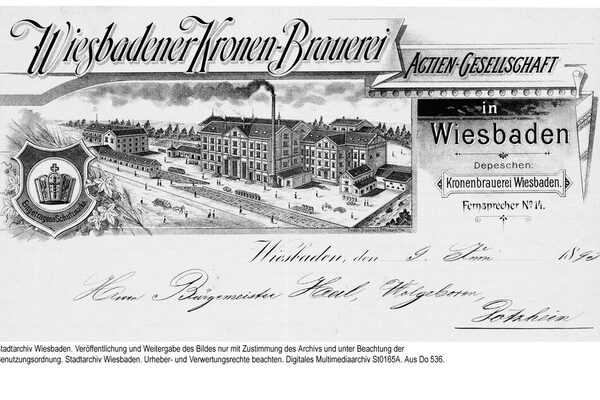Breweries
In the 15th century, most of the beer consumed in Wiesbaden was sourced from Bamberg and Mainz. This was mainly due to the fact that Wiesbaden, which was located close to the Rheingau as Nassau's main wine-growing region, was keen to keep beer consumption as low as possible. As late as 1579, the import of beer was forbidden under penalty of punishment, as the price was sometimes less than half the price of wine. Despite this, beer consumption in the Wiesbaden area rose steadily. In 1803, brewers from Eltville filed a lawsuit in Wiesbaden against innkeepers who were buying their beer cheaper from the French side of the Rhine. They were proved right, and beer from the other side of the Rhine was subject to an import duty.
Wiesbaden beer did not have a good reputation at this time, so the brewers' guild pushed for measures against the import of foreign beer in order to be able to continue selling their product. This attempt failed in 1812, as the uncompetitive beer could not survive on the now free market, and so the municipal brewery on the Michelsberg on the corner of Hochstättenstraße was sold at public auction in 1816.
Further difficulties arose with the introduction of a general beer tax in 1858, resulting in a sharp decline in production volumes in the Duchy of Nassau. Wiesbaden was the exception here. At 6,265.6 hl, the five Wiesbaden breweries produced far more than the average 150 hl of the other Nassau breweries. In addition, 9,325.8 hl were imported from abroad in the same year. The quantities consumed in the barracks without excise duty are not known.
Nevertheless, the beer tax also marked the beginning of more difficult times for the Wiesbaden breweries, especially as they also had to pay a municipal excise duty. From 24 breweries in the Wiesbaden district (roughly the area of today's Wiesbaden city district without the eastern suburbs) in 1829, only 11 remained by the mid-1850s. Although there were 19 breweries again by 1866, there were only seven pub breweries left in the city around 1850. These breweries corresponded to Nassau's classic small breweries, which only produced beer for local consumption; they were unable to meet the city's overall demand.
Three quarters of the 19,200 hectolitres of beer consumed annually still had to be sourced from abroad. In order to no longer be dependent on these imports, a consortium led by the court procurator Karl Braun came together in 1857 to found a hydroelectric brewery in the Walkmühle near Wiesbaden. Around 30,000 hectoliters of Bavarian-style beer were to be produced here every year. The promised profit of 33%, which enabled the shareholders to sell their 3,500 shares quickly, could not be achieved, but the success of the company led to the founding of a second "Wiesbaden Actien-Bierbrauereigesellschaft" on Sonnenberger Straße in 1862. Beer output was also expected to be around 30,000 hl. After heavy losses, the rentier Salomon Marix developed the brewery into the largest in the city from the beginning of 1870 through skillful management and numerous innovations. In the 1880s, it became the property of the Berlin merchant Hermann Gratweil, who transformed it into the "Wiesbadener Kronen-Brauerei Actien-Gesellschaft" in 1887.
During this period under Prussian administration, the conversion of the boiler tax into a lower brewing malt tax made life difficult for the small breweries. As a result of high barley prices and low sales figures, other pub breweries and small businesses had to cease production.
In 1870, the Marix and Bücher breweries were the first to use steam engines, alongside the Wuth brewery in Biebrich. One year later, the Marix brewery finally established itself as the most successful company in Wiesbaden and became the most important brewery in South Nassau the following year.
In addition to poor wine harvests, the increasing number of construction workers in Wiesbaden led to increased beer consumption. In addition, the Wiesbaden breweries now consistently brewed a tasty, bottom-fermented draught and lager beer using the Bavarian method. This significant increase in quality and the use of large ice-making machines from the mid-1870s onwards led to the establishment of Wiesbaden's own brands and the displacement of the previously preferred foreign beers.
Increasing industrialization meant that the large breweries prevailed. In 1871 there were still nine breweries in Wiesbaden, by 1921 there were only two. The Germania brewery in Mainzer Straße and the Felsenkeller brewery in Bierstadter Straße continued to produce beer until the 1960s, before they were taken over by the Frankfurt brewery Henninger and finally closed down.
A few years ago, Wiesbadener Braumanufaktur reopened as a local brewery that produces various craft beers by hand.
Literature
Even, Pierre: The brewing industry in the Nassau region. In: Wiesbadener Leben 4/95 [pp. 4-9] and 6/95 [pp. 36 f.].
Theodor Schüler. Essays on the history of the city of Wiesbaden in the 17th-19th centuries. Edited by: Neese, Bernd-Michael, Wiesbaden 2007.
